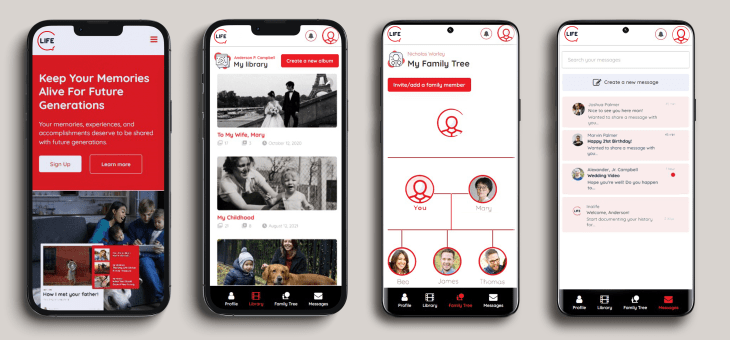A new startup, Inalife, has created a digital legacy platform that aims to help families preserve their precious memories, create an interactive family tree and even record messages for other members to be played at a date in the future — like when a new baby grows up and reaches adulthood, for example.
The Hong Kong-based company launched its desktop app in July, which attracted a few hundred users, but it now is hoping to gain more traction with the upcoming releases of its mobile apps for iOS and Android, due next week.
Inalife founder and CEO Nicholas Worley said he was inspired to create Inalife after losing members of his own family and realized he wished he had known more about their histories.
“The initial idea happened after my paternal grandfather passed away in 1999 from prostate cancer and my maternal grandmother the same year from Alzheimer’s,” Worley told TechCrunch. “After they passed away I had a dream where I saw them but they were my age,16, and when I woke up I realized I didn’t know anything about them aside from them being my grandparents. This included what they were like at my age, what they sounded like when they were young, or what their stories were — and that just made me incredibly sad,” he continues.
“I wanted to come up with a way to preserve our families’ memories at that point and I kept thinking about it over time,” he says.
The idea simmered until later after he became a parent himself with the birth of his son in 2019 which encouraged Worley to move forward with the idea. And after the birth of his twin sons in 2021 and the loss of his mother-in-law the following year, he created a plan to launch the business to help others also preserve their digital legacies.
To use Inalife, users can sign up for free, which offers them a “memory allowance” of 100MB of storage. They create their profile where they add information about themselves and add library albums filled with things like photos, videos, audio files and even documents. To add more data or create sub-accounts, users will need to upgrade to a paid subscription plan. These start at $5.99 per month for 5GB and range up to 30GB for $19.99 per month. Additional storage can also be added at a rate of $1.99 per 1GB.
After setting up your account, you then connect with other family members by adding them to your family tree. Each member receives an invite and can specify how they’re related. After joining, they can also browse the family tree and learn more about the other members of the family, as well as add their own albums and profile information. Sub-accounts can also be created for family members who have passed away or those who are too young to create their own profiles. (Kids can gain control of their profile through a transfer process when they’re older.)
In addition, users can send family members messages for others to listen to at a later date.
“The time-delayed messages are a novel way of preserving time capsule memories so loved ones can receive them at a specified date in the future,” explains Worley.
Users can also specify someone to manage their account in case anything happens to them.
Worley says this personal family data isn’t shared with third parties and the apps are ad-free because they’re paid for by subscriptions.
With the launch of the mobile apps planned for September 5, the founder’s goal is to reach a broader market. (After publication, the apps went live on iOS and Android.)
“With almost 7 billion people using smartphones globally and with our most cherished photos and memories stored on them, launching the app versions of Inalife was the next stage of our plan to help bring families closer together and let them connect across generations,” said Worley, in an announcement. “As we continue to increase our subscriber base, we are excited by the prospects for the company and are focused on providing customers with an authentic and valuable family experience while educating users around the world to the importance of preserving their digital legacies,” he added.
